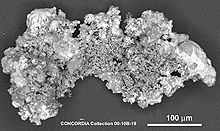
Micrometeorite

A micrometeorite is essentially a micrometeoroid that has survived entry through Earth's atmosphere. The size of such a particle ranges from 50 µm to 2 mm. Usually found on Earth's surface, micrometeorites differ from meteorites in that they are smaller in size, more abundant, and different in composition. They are a subset of cosmic dust, which also includes the smaller interplanetary dust particles (IDPs).Solar System → Local Interstellar Cloud → Local Bubble → Gould Belt → Orion Arm → Milky Way → Milky Way subgroup → Local Group → Local Sheet → Virgo Supercluster → Laniakea Supercluster → Observable universe → UniverseEach arrow (→) may be read as 'within' or 'part of'. A micrometeorite is essentially a micrometeoroid that has survived entry through Earth's atmosphere. The size of such a particle ranges from 50 µm to 2 mm. Usually found on Earth's surface, micrometeorites differ from meteorites in that they are smaller in size, more abundant, and different in composition. They are a subset of cosmic dust, which also includes the smaller interplanetary dust particles (IDPs). Micrometeorites enter Earth's atmosphere at high velocities (at least 11 km/s) and undergo heating through atmospheric friction and compression. Micrometeorites individually weigh between 10−9 and 10−4 g and collectively comprise most of the extraterrestrial material that has come to the present-day Earth. Fred Lawrence Whipple first coined the term 'micro-meteorite' to describe dust-sized objects that fall to the Earth. Sometimes meteoroids and micrometeoroids entering the Earth's atmosphere are visible as meteors or 'shooting stars', whether or not they reach the ground and survive as meteorites and micrometeorites. Micrometeorite (MM) textures vary as their original structural and mineral compositions are modified by the degree of heating that they experience entering the atmosphere—a function of their initial speed and angle of entry. They range from unmelted particles that retain their original mineralogy (Fig. 1 a, b), to partially melted particles (Fig. 1 c, d) to round melted cosmic spherules (Fig. 1 e, f, g, h, Fig. 2) some of which have lost a large portion of their mass through vaporization (Fig. 1 i). Classification is based on composition and degree of heating.
